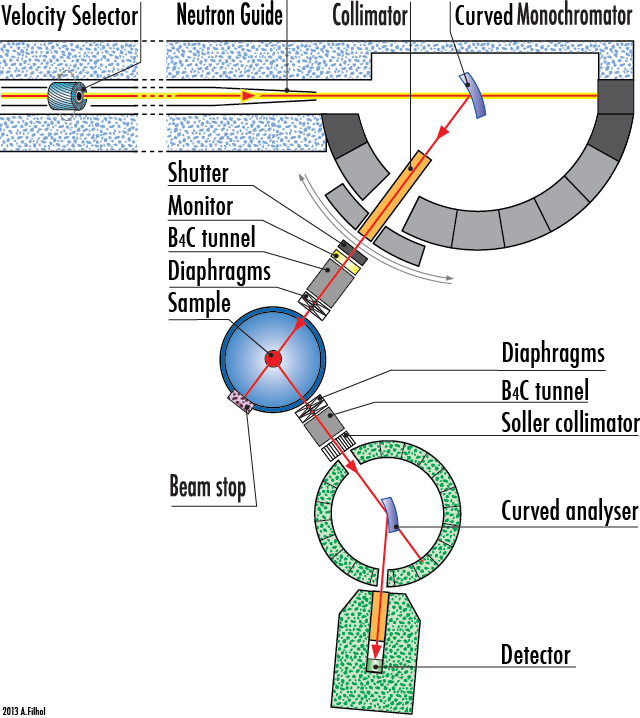IN12
CRG - cold neutron three-axis spectrometer
IN12 - Cold neutron three-axis spectrometer
IN12 is a three-axis spectrometer (TAS) for cold neutrons. It is operated by the Forschungszentrum Juelich in collaboration with the CEA Grenoble as a Collaborative Research Group CRG-B instrument at the ILL. The beamtime is shared amongst the collaborating partners and users can apply for beamtime via the respective institutes.
Users can choose between different sample environment equipments, e.g., high and low temperatures (3He and dilution inserts), high pressure, electric and magnetic field up to 15T, longitudinal or spherical polarization analysis (Cryopad), vacuum tank. IN12 also offers a very low background and low higher order contamination.
Applications
- Low energy magnetic excitation spectrum.
- Lattice dynamics at low frequency.
- Critical scattering and phase transition phenomena.
- Weak static magnetic moments (10-2 μB).
- Magnetic multilayers and thin films.
- Dynamics of amorphous materials at low momentum transfer.
- Dynamics of biological model membranes.
The layout of IN12
The upgrade of the H14 guide system moved IN12 to the Chartreuse side of the guide hall ILL7. It is situated now at an end position of the new supermirror guide H144 about 115m away from the vertical cold source.
A state-of-the-art guide layout using the virtual source concept, a new double focusing monochromator and modern optical components are employed for most efficient use of the delivered neutrons.
The guide leading to IN12 shows an overall 'S' curvature with m=2 coating. The last 80m of the guide have a curvature R=-2000m and a cross section dimensions of 45mm x 105mm (width x height) with tapering towards the guide end. The outer concave side of the guide is coated with m=2.4. On the last 8m the guide widens vertically from 105mm to 140mm for a more exact vertical focusing of the monochromator.
At the same time, to be able to focus on a smaller spot at the sample position (2cm x 3cm), we use the virtual source concept. The guide focuses horizontally down from 45 to 20mm in width. At the focusing guide end the coating of the side walls increases up to m=3.2. We installed a new double focusing PG monochromator in 1.8m distance from the guide end composed of 11 x 11 PG(002) crystals, with a size of 16cm x 20cm in total.
In between guide end and monochromator diaphragms are installed as well as optional a collimator and a Mezei-flipper far away from the sample position for allowing polarized neutron set-ups also in magnetic field experiments.
The neutrons pass a (variable) sample to analyzer distance of about 1.3m and a analyzer to detector distance of 0.72m.
We employ a PG(002) analyzer or optional a Heusler analyzer for the polarized neutron set up.
More than 36m upstream a velocity selector in the guide placed on a movable in/out table ensures a clean beam, preventing higher order reflections from the monochromator and reducing the background at the sample position.
Directly behind the velocity selector a vertical guide changing system with a normal guide element and a transmission polarizing cavity guarantees an easy-to-use polarization set-up.
This new layout for IN12 is optimized for a maximum flux at the sample position giving a low background at the same time.
We realize a great flexibility in choosing incident wavelengths and the signal-to-noise ratio has improved significantly with the upgrade.
Together with the excellent tunable resolution the high flux also for a polarized set-up allows for future demanding experiments.
The removable selector and the large accessible space behind the monochromator shielding guarantees a very competitive approach for using high ki values (i.e. ki=3.5-5Å-1). The instrument therefore can be easily used in the standard W-configuration where high energy transfers up to 10-25meV may be realizable.

